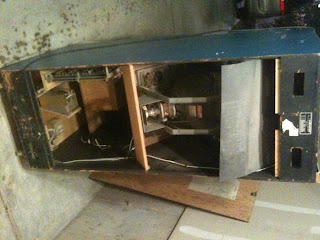Fast-forward to last week.
As I did my daily KSL listing search there it was—a Donkey Kong cabinet located in Tooele, Utah for $300. Not as good a deal as the previous, but enough to get me interested. The owner didn't know what was wrong with it. It had been sitting in his garage for two years, gathering dust. I talked him down to $150 over the phone and made my trek to Tooele after work on Wednesday night. After inspecting the unit I was able to talk him down to $130. On the drive home I wondered if I had made a bad decision. After all, I had no idea what was wrong but had some ideas on how to figure it out.
Upon arriving home I unloaded the cabinet and cracked open the sarcophagus. Ancient dust filled my lungs.
The bottom was in disarray. The rear wheels were attached, but the rest of the base was missing. As a result, the particle board on the front of the unit was worn down.
The top and back needed some TLC. Luckily, the cabinet still came with the original serial number plate on the backside.
In short, I had my work cut out for me.
On the inside of the cabinet was a small bag of goodies—a coin catcher, some fuses, and unidentified metal trinkets. I decided to start of with the basics. I swapped the fuse out for one of the replacement fuses in the bag, plugged the machine in, and flipped the switched.
BVVVVTTTTT!!!!
Uh-oh! I hoped I hadn't just fried the PCB (micro-chip game board). I looked at the screen and it was blank. I looked back into to the guts of the beast. My friend glanced back at the screen and calmly said, "Oh Logan..."
I looked back and there it was. The demo screen showed little jump man Mario climbing ladders and leaping over barrels. My investment had just tripled. I had all working electronics! I could barely believe I wasn't dreaming. I never get that lucky in life. After my buddy twisted around the 30-year-old florescent bulb in started to flicker and BAM! it came to life. A miracle. This particular bulb was made in Japan and it is nigh impossible to get a replacement for it today. It still had the factory tape over the bulb and Japanese writing all over it. The monitor is the original 30-year-old Sanyo 20EZ. It has absolutely no screen burn-in.
I cleaned off the bezel glass and marquee and took another shot:
The electronics were easier than expected to get working. Now it was time to get to work on the body of the beast. I got to work planning my attack strategy.
Today I made a trip to Home Depot and picked up some supplies to initiate Phase 1: Rebuilding the Base Frame. Pine 1x4 boards to create the four sides, black paint to make it look perty, and some particle board for Phase 2. Tomorrow I will be cutting my boards at 45° angles to make a box, then screwing it into the bottom of the cabinet.
The following is what I would like to do to restore this classic cabinet:
- Rebuild the base and attach it to the bottom of the cab.
- Saw off the bottom 1 1/2 inches on the sides that have been damaged and biscuit joint new bottoms on.
- Scrub down the outside more thoroughly, Bondo in the cracks and chips, and sand it down.
- Repaint the cabinet the DK light blue and black color.
- Disassemble the control panel and thoroughly clean it out, clean the buttons, re-grease the joystick, and possibly place in a new score card reproduction.
- Place new white t-moldings on the outside.
- Repaint the coin door, get the coin slots to accept quarters again. Sand blast the metallic coin slots so they look shiny and new.
- Plug in an additional chip that allows me to save high scores.
- Replace the power cord with a non-frayed one.
- Place a new cap kit on the monitor. The screen looks slightly distorted.
- Replace the lock mechanism on the back. It looks like someone lost the key and resorted to screwing the door to the cabinet to keep it shut.










